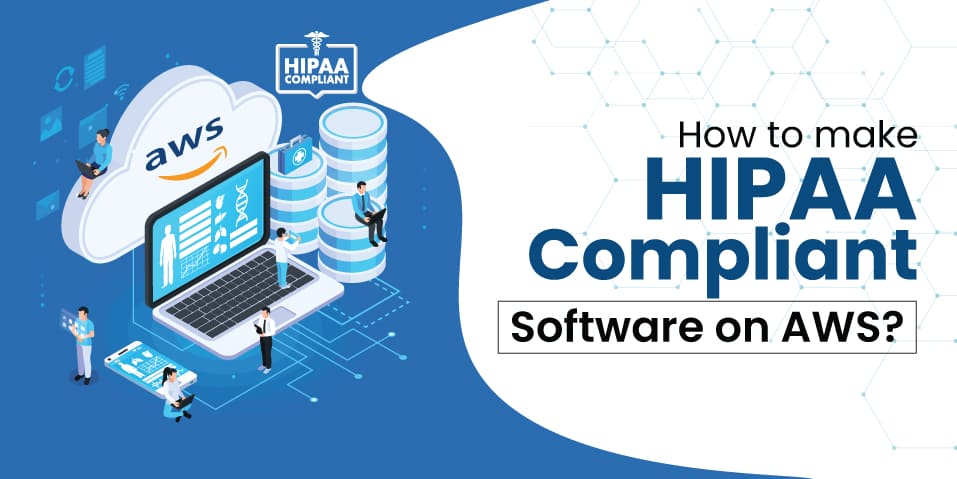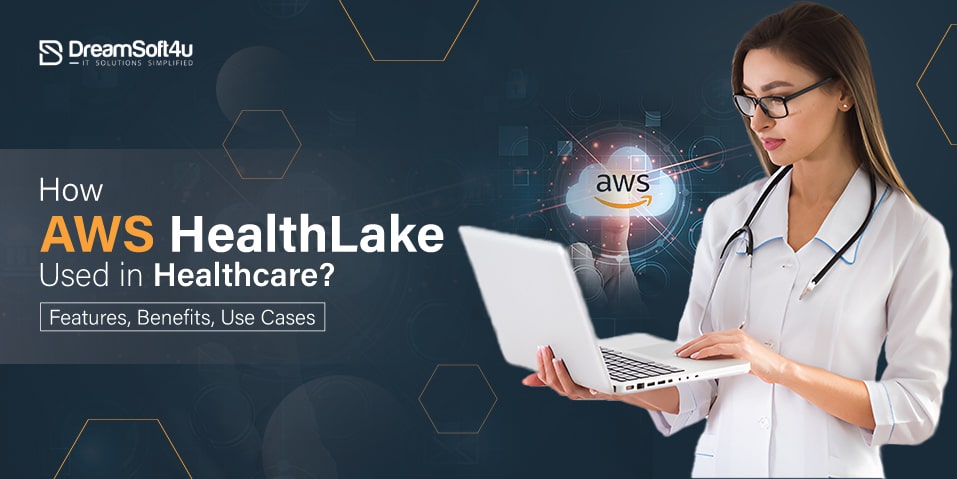What does HIPAA Compliant Software mean? How can it be developed? The health industry has decked up with technology and moving towards growth at its 100% pace. A HIPAA Compliant Application means that patient data will be under total security standards. This health compliance is also supported by Amazon’s (the tech giant) cloud service i.e. AWS (Amazon Web Services). It is supported by AWS Cloud storage for better security of patient data. The article is a guide on How to make HIPAA-compliant software on AWS. Simultaneously, the user gets acquainted with its certification and eligibility to be a HIPAA-compliant agency.
To facilitate HIPAA Compliance, a company should accommodate protected health information (PHI) by holding physical networking and delivering sustainable security measures. The US Department of Health and Human Services (HHS) has necessitated this rule in each hospitality service provider and abides by strict laws.
Table of Contents
ToggleIs Amazon Cloud HIPAA compliant?
To be HIPAA Compliant, a company needs to handle protected health information (PHI) with strong security measures. The US Department of Health and Human Services (HHS) made this rule to ensure safety in healthcare services.
Amazon Web Services has all the protections to satisfy the HIPAA Security Rule and Amazon will sign a business associate agreement with healthcare organizations.
So, is AWS HIPAA compliant? Yes. And No.
AWS can be HIPAA compliant, but configuration mistakes can expose PHI. Organizations using AWS are responsible for ensuring HIPAA compliance and must properly configure AWS services to safeguard PHI and prevent violations. unprotected and accessible by unauthorized individuals, violating HIPAA Rules.
Read Also: 10 Best Cloud Security Practices For Software Development
Is AWS HIPAA certified?
There is no HIPAA certification for a cloud service provider (CSP) such as AWS. To meet HIPAA requirements for our operating model, AWS follows higher security standards aligned with FedRAMP and NIST 800-53, which map to the HIPAA Security Rule. AWS aligns our HIPAA risk management program with these standards to ensure compliance.
HIPAA Compliance Myths & Misconceptions:
Let’s simplify some common misunderstandings for a smoother journey.
Myth 1: “AWS Takes Care of Everything – We’re Covered!”
AWS is a good starting point, but it’s not a superhero. Think of it as a trusty partner; you still need to adjust settings, control access, and add protections for your healthcare data.
Myth 2: “HIPAA Compliance is Just for the Big Players, Not Us!”
HIPAA compliance – it’s for everyone. Whether big or small, if you handle patient data, follow the rules. The rules are the same; you adapt them to fit your organization.
Myth 3: “Encryption? That’s Just Extra – We Can Skip It!”
Encryption isn’t extra; it’s like a superhero cape in HIPAA land. Skipping it is like sending patient data on a postcard for everyone to read. AWS suggests encrypting data for safety.
Myth 4: “We Don’t Need to Bother with Audit Trails – Nothing Ever Goes Wrong!”
Even smooth journeys have bumps. Audit trails are like your travel diary, noting every step. They’re not just for problems but to enhance security. AWS says turning on audit trails is proactive data protection.
Myth 5: “Once HIPAA Compliant, Always HIPAA Compliant – No Need to Check Again!”
HIPAA compliance is ongoing, like maintaining a healthy lifestyle. Regularly check your setup, update security, and adapt to changes. Compliance is a journey, not a one-time thing.
Myth 6: “AWS Will Notify Us of Any Compliance Issues Automatically!”
Reality: AWS is helpful but not a mind reader. Watch for and fix compliance issues. Stay alert, check regularly, and solve concerns for a solid compliance plan.
Myth 7: “HIPAA Compliance – Just a Box to Tick for Legal Reasons!”
Reality: HIPAA compliance isn’t just a legal box to tick; it’s a promise for patient trust and data security. Embrace it for trust, not just rules, in the healthcare world.
In the world of HIPAA compliance on AWS, separating fact from fiction is the key. Now that we’ve cleared up these myths, let’s keep going with a clear and confident understanding.
Read Also: An Ultimate Guide to Modern Software Development Security Risks
How to Build HIPAA-Compliant Applications on AWS?
To get along with your business with AWS HIPAA Compliance, one has to satisfy some clauses as given in the eligibility parameters below. Millennials today, utilize this mechanism to advance their security standards. The utilization of AWS services initiates HIPAA Service List to build scalable, secure, and fault-bearing solutions.
So let’s get started!
What is required to be HIPAA Compliant?
There are a few privacy rules that need to be followed to be HIPAA Compliant. These are a set of national standards to ensure the security of people’s medical data and personal health information (PHI). Moreover, this is also applied to health plans, healthcare clearinghouses, and those who perform medical transactions electronically.
Therefore, our team has shared the AWS HIPAA Compliance best practices and checklist for better understanding. Read all the eligibility parameters carefully:
AWS Best Practices for HIPAA Compliance:
When it comes to making your software HIPAA-compliant on AWS, it’s not just about the destination – the journey matters too. Let’s explore some best practices recommended by AWS to ensure your healthcare data is always secure.
- Access Controls
In AWS, think of your account like a VIP party – not everyone should have full access. AWS suggests strong access controls, acting like a doorman to let only the right people in.
- Encryption
Encrypting data is like putting it in a secret code. AWS recommends using encryption to keep your healthcare data safe, creating a secret language only you and trusted colleagues can understand.
- Audit Trails
Audit trails are like the detectives of AWS. They record who did what and when. AWS suggests turning on audit trails to track suspicious activities, so you can investigate if something goes wrong.
- Incident Response
Even superheroes have backup plans. AWS suggests having an incident response plan – a step-by-step guide for unexpected situations. It’s like having a toolkit of solutions for any challenges.
Read Also: Key Laws for Medical Software Development
AWS HIPAA Compliance Checklist
- HIPAA Privacy Rule: This focuses on the patient’s right to access PHI and the healthcare right to deny that access.
- HIPAA Security Rule: This deals with the security, transmission, and dealing of electronic PHI (e-PHI). This concentrates on the security of e-PHI.
- HIPAA Breach Policies: This is meant for entities and business associates found in e-PHI or PHI data breaches. There are specific protocols based on the kind of data breach.
- HIPAA Omnibus Rule: This is meant for business organizations to mandate HIPAA compliance at their premises.
These are a few parameters that need to be followed with HIPAA compliance. Now, let’s get started on how to make my AWS HIPAA-compliant. But before this, we will get familiar with the HIPAA Certification process. It is the main step in setting up the HIPAA Compliance Software using AWS.
How to get HIPAA Certification?
If you see an organization stating we are HIPAA Compliance, you must be aware of the fact that the organization has successfully gone through a course, developed to train and teach the information you need to apply in the business.
Steps to get HIPAA Certification:
- You need to choose a course that suits your employee learning standards.
- The certification requires all people to participate, but if you are low on finances, then select people who can be trained as trainers.
- Train the trainer means, your selected employee will train the other staff, not the professional ones.
- These HIPAA-certified individuals can then run training programs on-site for others so that an acknowledgment of the Act can be triggered on the whole campus.
- The company must accommodate the HIPAA Policy, featuring the same terms or conditions as in the company’s health and safety policy.
- The selected applicants (trained for trainers) will be examined monthly for a proper compliance check.
- Now the HHS authorities will evaluate the compliance and then will provide you with the certificate.
How to make HIPAA-compliant software on AWS?
AWS or Amazon Web Services helps you to circulate, manage, and keep PHI as per the HIPAA and HITECH compliance needs. The AWS Cloud Services and data centers have manifold layers of physical and operational security to guarantee the security of customer data.
Before any construction and safekeeping of any PHI information on the AWS platform, the organization has to sign the Business Associate Agreement (BAA) with AWS. The agreement clarifies and limits the requested use and disclosure of PHI.
HIPAA Rules require the covered entities and business associates to get into a contract to confirm the proper security of PHI. The business associates are the persons or organizations that deliver functions or activities and are not put to work by the covered entity.
So as per the policy, AWS becomes the business associate while the healthcare company or business that developed it will become the covered entity.
Once, the organization has signed the BAA with AWS, the account will then be treated as a HIPAA Account. Now all the PHI data will be maintained and stored in it. Similarly, the BAA is transferable, when you are selling your application as a SaaS-based solution.
Now that you have signed the bond with AWS, start building your infrastructure where you move your PHI to Amazon Web Services. To do so, you have to fulfill the following necessities:
- All the movable information will be encrypted first.
- PHI should be backed up and it is recoverable.
- The information is managed by an authorized person.
- The information so obtained should not be tampered with or altered.
- When information is not needed, permanently discard options are there.
- You have to be careful with the utilization and avoid the compliance rules.
Let us help you develop a HIPAA-compliant software application on AWS.
Contact us today
98+ Client Retention
Top Features of HIPAA-Compliant Software: Patient Data Security and Beyond
Here are some of the key features that should be present in any HIPAA-compliant solution:
Security and Encryption:
- Data Encryption: Securely encrypt all patient data with AES-256.
- Access Controls (RBAC): Restrict access to authorized personnel using RBAC.
- Multi-Factor Authentication (MFA): Add an extra layer of security with MFA.
- Audit Logs: Monitor user activity, including access attempts and modifications.
Privacy and Transparency:
- Secure Storage: Use Amazon/Azure cloud storage or dedicated servers with robust security.
- Backup and Recovery: Regularly back up data and have a disaster recovery plan for emergencies.
- Data Disposal: Follow procedures for secure patient data disposal post-retention period.
Additional Features:
- Mobile-friendliness: Ensure the software is accessible on mobile devices with appropriate security measures.
- Telehealth capabilities: Integrate features for secure online consultations and virtual care delivery.
- Reporting and analytics: Provide tools for generating reports and analyzing data while maintaining patient privacy.
- Compliance training: Offer training to staff on HIPAA regulations and best practices for handling patient data.
Final Words:
So these were the suitable details on How to make HIPAA-compliant software on AWS? Any company or organization related to healthcare has to follow compliance. Agencies that do not adhere to the compliance, are being penalized up to $100 to $50,000 per violation. The highest HIPAA Compliance Penalty can range to $1.5 million per year. So be cautious when adopting this super secure HIPAA Compliance with AWS Cloud.
Looking for a reliable HIPAA-compliant software development company? Look no further than DreamSoft4u. Our experienced team can expertly guide you through the development process.
FAQs
Q. Why is HIPAA compliance important for healthcare software?
HIPAA compliance helps keep medical records, diagnoses, and billing information safe. You earn patient’s trust by preventing unauthorized access, use, or disclosure.
Q. What affects the cost of HIPAA-compliant software on AWS?
Cost factors include:
- Project size: Bigger projects cost more due to more resources and time.
- HIPAA compliance level: Different levels have different requirements and costs.
- Infrastructure changes: Upgrading for HIPAA standards adds to the cost.
Q. How big is the team for HIPAA-compliant software on AWS?
The team size depends on the project’s scope but typically involves:
- Developers: Build and maintain the software application.
- Security specialists: Ensure robust security measures are in place.
- Compliance experts: Guide the project to meet HIPAA regulations.
Q. Which AWS services are commonly used for HIPAA-compliant software?
Several AWS services are widely used for HIPAA compliance, including:
- Amazon S3: Securely stores patient data in the cloud.
- Amazon RDS: Manages HIPAA-compliant databases.
- Amazon CloudWatch: Monitors and logs activity for security and compliance.
Q. How do AWS services help with backup and disaster recovery?
AWS services offer several features for backup and disaster recovery:
- Automated backups: Regularly back up your data to prevent information loss.
- Replication across regions: Store data copies in multiple locations for redundancy.
- Disaster recovery plans: Have a clear strategy to restore data in case of emergencies.
Q. Are you a registered AWS vendor?
Yes, we are a registered and official AWS vendor. This ensures we have the expertise and knowledge to help you build and deploy HIPAA-compliant software on AWS reliably.











